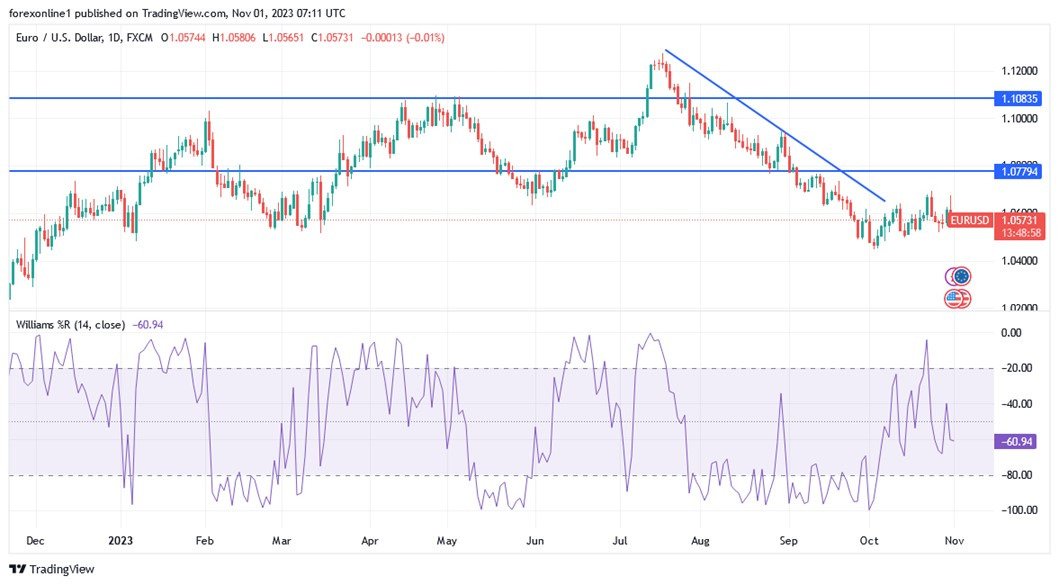- The Euro price tried to hold on to its gains after Eurozone inflation came in below 3.0% but core inflation remains “sticky.”
- Yesterday, the gains in the price of the currency pair EUR/USD reached the resistance level of 1.0675, but with the return of the demand to buy the US dollar as a safe haven, it moved back down with losses that affected the support level of 1.0557 before settling around the 1.0585 level at the time of writing the analysis.
Top Forex Brokers
Eurozone Data in Focus
Eurozone inflation is back below 3.0% but core CPI approaching 4.0% will keep the ECB cautious and support the euro. According to the principles of the Forex currency market, the euro should rise when inflation data exceeds expectations, as this enhances the possibility of an increase in interest rates supporting bond yields in the European Central Bank. But that is no longer the case, the euro is rising in the wake of October Eurozone CPI data, suggesting that rapidly falling inflation is now quite supportive. Meanwhile, inflation data from Germany, France, Portugal, and Spain came in below expectations, leading to the Eurozone CPI recording 2.9% year-on-year in October, down from 4.3% in September.
Therefore, this puts it comfortably below the 3.1% level the market had expected and could allow the ECB to ease monetary conditions by lowering interest rates earlier in 2024 than previously expected. Meanwhile, it may be too early to expect the ECB to declare a full recovery on inflation. However, statistics office Eurostat reported that core CPI inflation fell to 4.2% from 4.5% previously, putting it in line with analysts' expectations.
Commenting on this, Mark Wall, chief European economist at Deutsche Bank, said: “Eurozone inflation fell more than expected again in October, falling below 3% for the first time since mid-2021. The European Central Bank will keep this news at a distance.” Adding, “Core inflation remains above 4%, twice the inflation target. Also, the ECB needs to see wage inflation slow, and this could take another six months.”
Consequently, a higher core CPI inflation rate will provide some support to euro area bond yields, which could provide continued support to euro exchange rates. Moreover, a drop in the headline inflation rate to below 3.0% also supports the euro, as it eases pressure on companies and consumers in the eurozone, improving the outlook for the economy, which is ultimately the surest guarantor of the currency's valuation.
According to Forex market trading, the euro-to-pound exchange rate reached a new five-month high on Tuesday as it continued to touch 0.8746, which equates to a new multi-month low for the pound-to-euro rate of 1.1433. Recently, the EUR/USD exchange rate rose by a quarter of a percent to 1.0650 and increasingly looks as if it has emerged from the July-October sell-off. However, the euro lost some of its shine after the release of official euro zone GDP numbers for the third quarter, which came in below expectations at 0.1% year-on-year in the third quarter, down from 0.5% in the second quarter. Meanwhile, the market was looking at 0.2% and Tthis came after the quarter-on-quarter change was -0.1%, a decline of 0.1% in the second quarter and less than the 0% that the market expected.
EUR/USD Today Expectations and Analysis
According to the performance on the daily chart below, the general trend of the EUR/USD is still bearish. Nearby, EUR/USD is approaching the psychological support 1.0500 will continue to support the bears’ control over the trend and herald a stronger downward move. Incredibly, investors will not care much about the movement of technical indicators towards strong oversold levels as much as they will monitor the reaction to the US Federal Reserve’s announcement today and the US job numbers on Friday. Technically, a first break of the general downward trend for the EUR/USD will not occur without the bulls moving towards the resistance levels of 1.0720 and 1.0800, respectively.
Ready to trade our daily Forex analysis? We’ve made a list of the best forex trading accounts worth trading with.

